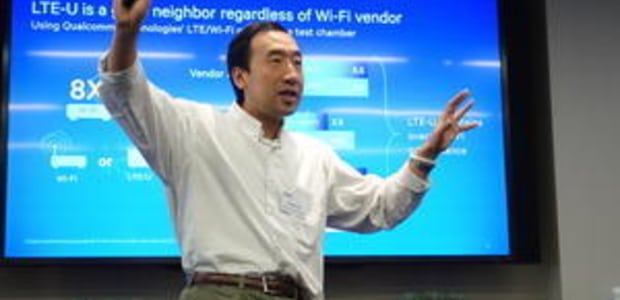advertisement
Tensions rise over LTE using Wi-Fi channels
The fight over LTE networks sharing channels with Wi-Fi appears to be heating up.The Wi-Fi Alliance says that by September…

The fight over LTE networks sharing channels with Wi-Fi appears to be heating up.The Wi-Fi Alliance says that by September there will be a way to test whether an LTE device can get along with Wi-Fi. But Qualcomm, one of the biggest backers of LTE-U (LTE-Unlicensed), is demanding those tests immediately.
The latest disagreement arose after a workshop held last Wednesday, the latest in a series aimed at crafting a test plan for coexistence between the two technologies. That test plan, which is designed for new products that use LTE in unlicensed bands, will be finished and verified by late September, WFA said.
That’s at least a month later than some earlier forecasts. Test development has taken a long time because it’s an unprecedented project and the tests still need to be validated, WFA marketing vice president Kevin Robinson said.
advertisement
But when asked about the latest workshop, Qualcomm tore into the industry group, of which it is a member.
“Qualcomm is disappointed with the continued delays in finalizing a LTE-U/Wi-Fi test plan with the Wi-Fi Alliance, as well as with the substance presented by the WFA staff at last week’s WFA workshop, which lacked technical merit and was a sharp departure from Wi-Fi Alliance staff past presentations and views and from the view of any other standards body or regulator around the world,” wrote Dean Brenner, senior vice president of government affairs, in a written statement on Monday.
None of the companies at the workshop supported the WFA staff’s views, Brenner said. The test plan should be ready to go, he said. Qualcomm brought its own LTE-U prototype equipment into the WFA’s lab last month and verified the test plan for all the tests that were run, according to Brenner.
advertisement
“We believe that it is time to end the validation process, and deem the original test plan final so that the public can experience as soon as possible the improved services that LTE-U will provide,” Brenner wrote.
WFA did not immediately respond to Brenner’s statement.
“Wi-Fi Alliance understands the desire of the LTE-U community to get that equipment tested in as timely a manner as possible,” Robinson said in an interview earlier on Monday.
advertisement
LTE-U is a form of cellular that operates in some of the same frequencies that Wi-Fi users rely on. Qualcomm and others have said the new technology should have access to the band.
“This whole process has gone on for more than a year, and no new technology for unlicensed spectrum, which is supposed to be available for permission-less innovation, has gone through vetting this long or this extensive,” Brenner wrote.
Unlicensed LTE is designed to give mobile operators more spectrum to work with as they try to serve subscribers in crowded places. Verizon, T-Mobile USA and other carriers have talked about rolling it out as soon as the end of this year.
But some backers of Wi-Fi, including the Alliance, have said LTE-U could make it hard for wireless LAN users to get a packet in edgewise. Fans of the new technology, including Qualcomm, say it won’t add any more interference than a new Wi-Fi access point would.
The WFA held its first industry workshop on interoperability last November. There, the group joined cellular and Wi-Fi companies to talk about tests that would determine whether a new product could cause unfair interference. Qualcomm, which participated in that first meeting, forecast at the time that a test plan might be ready in February.
More recently, the WFA had estimated development would take until at least August.
This is the first effort of its kind between two different industries – Wi-Fi and LTE – so there is much that has had to be worked out, Robinson of the alliance said. Most of the remaining work will go into verifying that the test plan works reliably, he said. The tests are designed to ensure that introducing an LTE-U product amid Wi-Fi networks wouldn’t be any worse than adding one more Wi-Fi acess point.
As soon as the test plan is finished and verified in September, there will be at least one approved third-party lab where vendors can take their products for testing. The process for each will take a couple of weeks or less, Robinson said.
One reason for the growing tension may be a fear that time running out for LTE-U even after big investments in it by Qualcomm and others.
Another form of unlicensed LTE, called LAA (Licensed-Assisted Access), is completed and headed toward commercial release. LAA includes more features to ensure it coexists with Wi-Fi, and it’s permitted in more parts of the world than LTE-U, such as in Europe. The major makers of LTE-U technology, including Qualcomm, are also pursuing LAA.
WFA expects the tests being developed now to work with LAA too.